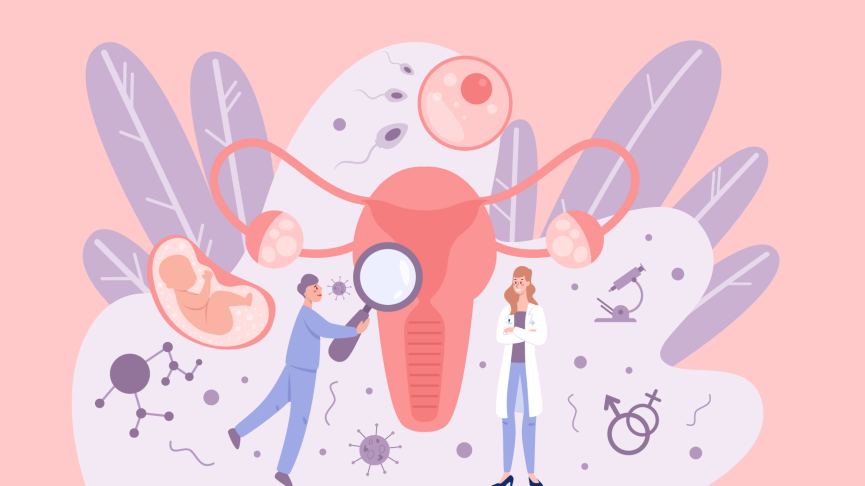What is Pyosalpinx and How May it Affect Fertility?

Pyosalpinx. Unless you’ve experienced this oftentimes painful condition, you’ve probably never heard of it.
As you deepen your knowledge of reproductive health, this is an important ailment to be aware of, as it can not only be painful but affect your fertility as well.
What is Pyosalpinx?
Simply speaking, Pyosalpinx is the build-up and accumulation of pus in the fallopian tubes, causing them to swell. Ouch!
This is most common in people ages twenty to forty but can occur in younger and older people as well.
Typically this is a response to an infection in the body, which may or may not be caused by a sexually transmitted infection. The body responds to an infection by increasing its production of white blood cells. Pus is caused by a buildup of these white blood cells, a natural part of the body’s immune response and healing process. If this pus builds up in fallopian tubes, it leads to pyosalpinx, causing them to swell and expand.
What Causes Pyosalpinx?
Like we mentioned, pyosalpinx is a complication of the body’s immune response to an infection, or as a direct result of an infection.
What infections you may ask?
Pelvic Inflammatory Disease is the main culprit, with sixteen percent of cases resulting in pyosalpinx. PID is diagnosed in more than one million women each year in the U.S. alone, which means pyosalpinx may be more common than you think.
PID is typically caused by two main STIs; gonorrhea and chlamydia. It can also be caused by non sexually transmitted infections like bacterial vaginosis, BV. Rarely, pyosalpinx can result from a pelvic tuberculosis infection.
There are a few other documented instances of pyosalpinx developing from other causes.
In one rare case, a woman who was swimming in tropical waters whilst on vacation, came down with an infection from the bacteria Plesiomonas shigelloides. The patient had undergone tube sterilization twenty years prior to the infection, and while swimming, the bacteria presumably went up the fallopian tubes to the sterilization scar, causing pyosalpinx. She recovered after laparoscopic surgery and a course of antibiotics.
In another rare case, a woman was diagnosed with pyosalpinx, after her copper Intrauterine Device, IUD, migrated, leading to infection. A rare complication of this common contraceptive tool.
What are The Symptoms of Pyosalpinx?
While some people may not exhibit symptoms, others can range from uncomfortable, to extremely painful.
Possible symptoms include those you would experience with infection including fever, fatigue, and body aches – especially in the pelvic area. Although uncommon, abnormal vaginal discharge may also be a sign of pyosalpinx.
It’s common with pyosalpinx to have constant or intermittent pain in the lower belly, a painful lump in lower belly, abnormal pain before your period, and pain during sex.
A disheartening complication of pyosalpinx is difficulty conceiving or infertility.
Pyosalpinx and Infertility
Because pyosalpinx damages or blocks the fallopian tubes with pus, it makes it difficult or impossible for an egg to travel down them before implanting in the uterus.
Pyosalpinx may increase the chance of an ectopic pregnancy, a possibly life-threatening complication, where the fertilized egg implants outside the uterus.
If surgical treatment is necessary in order to treat pyosalpinx, it can damage or remove the organs needed to conceive and carry a pregnancy to term.
How is Pyosalpinx Diagnosed?
Pyosalpinx may be diagnosed using a variety of methods, including swabbing, blood tests for infection, imaging and possible surgery.
Your healthcare provider may use a pelvic MRI, pelvic ultrasound (either abdominally or transvaginally, or a CT scan.
Because of the location of the infection, a diagnostic laparoscopy may be necessary in order to give a proper diagnosis. This minimally invasive surgery uses small incisions in order to examine the abdominal organs with a camera at the end of the instrument. Your provider may also take a small sample of tissues to do a biopsy on, so that they can rule out possible cancer or other illnesses.
How Do You Treat Pyosalpinx?
Treatment for pyosalpinx depends on the individual case.
Typically antibiotics used to treat the initial infection will help to clear the fallopian tube of its pus build up. Depending on the severity of the infection, antibiotics might need to be given in the hospital intravenously.
In chronic or more severe cases, treatment may require surgery, in addition to antibiotics.
Laparoscopic surgery is the least invasive surgical option, and helps to preserve the reproductive organs. This may damage or require removal of the organs needed to conceive and carry a pregnancy to term, which can affect someone’s ability to naturally conceive.
Bilateral (both) salpingectomy or unilateral (one) salpingectomy, is the removal of the fallopian tube(s).
Oophorectomy removes one or both ovaries. In a bilateral oophorectomy, both ovaries are removed, whereas in a unilateral oophorectomy only one is removed.
In some cases, a provider may recommend a Hysterectomy or removal of the uterus. They may also remove the fallopian tubes, and or ovaries, and possibly the cervix.
All of these procedures come with an increased risk or certainty of infertility.
Preventing Pyosalpinx
Given that pyosalpinx is most commonly caused by STIs, the best way to prevent it is by using safe sex practices like using condoms and discussing each other’s STI status’ with sexual partners.
While it’s always a good idea to get tested for STIs at least once a year, including chlamydia and gonorrhea, you should get tested more often if you have multiple sexual partners.
If you do test positive for one of these infections, don’t worry, it’s part of being human, and you didn’t do anything wrong.
The most important thing to do is start treatment immediately, and disclose your status to any recent sexual partners.
Because of its potential impact on fertility, if you suspect an infection, visit your doctor ASAP, so that they can diagnose and treat your early on.
You can also help prevent pyosalpinx and other infections by maintaining a healthy pH balance and keeping your vaginal flora healthy and thriving. Simple things like wiping front to back, peeing after sex, eating a balanced diet, and avoiding toxic chemicals near the vagina and vulva all help to keep your reproductive organs happy. Taking care of your overall health and immune system by eating a diet high in antioxidants, can reduce your risk of a severe infection.
Facts Checked By:

Dr. Shree Datta is a Consultant Obstetrician and Gynaecologist in London, specialising in women’s health including all menstrual problems such as fibroids and endometriosis. Dr. Shree is a keen advocate for patient choice, having written numerous articles and books to promote patient and clinician information. Her vision resonates with INTIMINA, with the common goals of demystifying periods and delivering the best possible care to her patients.
Article written by:

Natasha (she/her) is a full-spectrum doula and health+wellness copywriter. Her work focuses on deconstructing the shame, stigma, and barriers people carry around birth, sex, health, and beyond, to help people navigate through their lives with more education and empowerment. You can connect with Natasha on IG @natasha.s.weiss.


